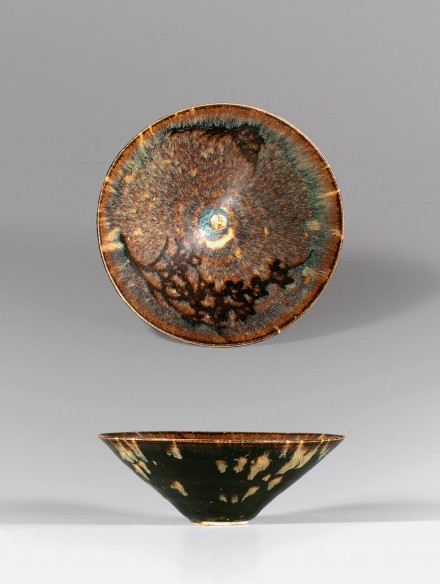J.J. Lally & Co., Oriental Art / New York City, New York
MenuPast Exhibition
SONG DYNASTY CERAMICS:
The Ronald W. Longsdorf Collection
March 15 - April 13, 2013

38.
A JIZHOU PAPER-CUT DECORATED PHEASANT AND
BLOSSOMING BRANCH CONICAL TEA BOWL
Song Dynasty (A.D. 960-1279)
with thinly potted very gently rounded flaring sides decorated on the interior with paper-cut stenciled designs of a pheasant in flight opposite a blossoming branch reserved in brown-black glaze on a dramatically streaked reddish-brown background glaze suffused with cloudy bluish mottling throughout and with a concentrated band of milky blue tone below a narrow dark brown border just below the rim, the reverse covered with a ‘tortoiseshell’ glaze unevenly splashed with caramel-colored markings over a dark brown ground, the neatly pared small ring foot and countersunk base unglazed, showing the pale buff pottery.
Diameter 6 1⁄16 inches (15.4 cm)
A very similar Jizhou conical tea bowl of this rare size and pattern in the collection of the Kyoto National Museum is illustrated in the catalogue of the exhibition mounted at the Asia Society by Hayashiya and Trubner, Chinese Ceramics from Japanese Collections: T’ang Through Ming Dynasties, New York, 1977, p. 76, no. 37, described as formerly in the possession of the Maeda family. The lengthy caption in the catalogue includes the statement: “This type of temmoku bowl was frequently mentioned in records of the early Muromachi period, and it is believed that this rare piece was brought to Japan at that time.” The same tea bowl was included in the travelling exhibition organized by Tobu Museum of Art, Hagi Uragami Museum, and The Museum of Oriental Ceramics, Osaka, entitled Sōji: shinpin to yobareta yakimono (Song Ceramics), Tokyo, 1999, p. 118, no. 80.
Compare also the Jizhou conical tea bowl of smaller size decorated with the same paper-cut stenciled design on a similarly streaked background glaze in the collection of the Palace Museum, Beijing illustrated in Zhongguo wenwu jinghua daquan: Taoci juan (Compendium of Chinese Archaeological Treasures: Ceramics), Hong Kong 1993, p. 294, no. 417.
Another example of this rare pattern and form is illustrated by Wu, Earth Transformed: Chinese Ceramics in the Museum of Fine Arts Boston, Boston, 2001, pp. 80-81, from the William Sturgis Bigelow Collection, where the author states: “symbolically, the combination of pheasant and blossoming branch was considered auspicious, known as jin shang tian hua (literally, “adding blossoms to brocades”, or heaping splendor upon splendor), it was a play on the word jin (brocade) which is contained in the Chinese character for “pheasant.”
宋 吉州剪紙貼花折枝雉鳥紋斗笠碗 徑 15.4 厘米
38.
A JIZHOU PAPER-CUT DECORATED PHEASANT AND
BLOSSOMING BRANCH CONICAL TEA BOWL
Song Dynasty (A.D. 960-1279)
Diameter 6 1⁄16 inches (15.4 cm)